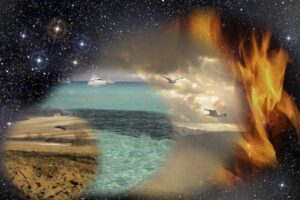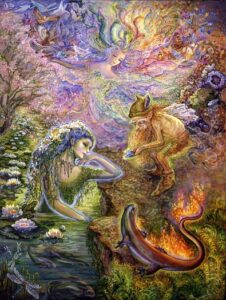The wind is in truth the All-Devourer, for when the fire dies out it goes into the wind, when the sun sets, it goes into the wind, when the moon sets, it goes into the wind, when the waters dry up, they go into the wind, for the wind consumes them all. Thus it is with respect to the divinity. And now with respect to the self. The breath is in truth the All-Devourer, for when a man sleeps, speech goes into breath, the eye goes into breath, the ear too, and the manas, for the breath consumes them all. These then are the two All-Devourers; wind among the gods, and breath among living men. ~ Chandogya Upanishad
Music can be understood as an objectification of the spirit; it does not express knowledge in the usual logical, intellectual sense, nor does it shape matter; instead, it gives sensuous representation to our deepest associations and most immutable laws. ~ Emma Jung, Animus and Anima
 The corporeal world is, in Tradition, composed of five basic elements: Ether, Air, Fire, Water, and Earth. That means that the world was understood in a qualitative, not quantitative, sense. As such, they represent the different densities of matter.
The corporeal world is, in Tradition, composed of five basic elements: Ether, Air, Fire, Water, and Earth. That means that the world was understood in a qualitative, not quantitative, sense. As such, they represent the different densities of matter.
Some see it that formulation a proto-science proposed by the ignorant. That cannot be true because the Traditional understanding is vertical: the qualities of the elements form the corporeal world. Science works horizontally: it measures data and proposed some theory to explain the qualities of the elements.
Ether
Ether lies at the border between the gross and subtle bodies. Time comes into manifestation with the subtle body, but space arises in gross body; that is why ether is associated with space.
Ether is associated with the sense of hearing, since it is the most ethereal. Sound arises from anywhere, not dependent on the line of sight. The highest expression of hearing is music. As Schopenhauer pointed out, music, of all the arts, does not represent any specific material entity. Sculptures do; painting does, despite attempts at pure abstraction, which nevertheless rely on shapes and colours; poetry and literature present natural and human events. But music comes from a different realm altogether. Birds don’t even sing in musical keys.
Revelation also comes through hearing, more effectively than visions.
Fire
Fire is form—or essence—without matter. The essence has not yet taken substantial form. That is why the question, “Where does the fire go when you blow it out?” has no answer, actually not even any meaning. Sight, therefore, is the sense associated with fire; you can see it, but not touch it.
The rainbow is another example of the fire element; it can be seen, but never reached or touched. Hence, fire can create images of spiritual things which have individuated forms, yet have not fully materialized in matter (i.e., the earth element).
It is manifested in life as the organs of locomotion, such as legs, wings, and so on.
Air
The air element is associated with touch, since it is the first tangible element. As the Chandogya Upanishad points out, it is the most fundamental element. Everything ultimately becomes air. It occupies the space between the solid earth and the lunar sphere.
The organs of touch, like arms, tentacles, or paws, are used to extend one’s reach beyond a single spot.
Water
Water is associated with the sense of taste. Its organ are the genitals, because it is a sign of renewal.
Earth
Earth is associated with the sense of smell and the organs of excretion, which return substances back to the earth. Its symbol is Prometheus, who discovered fire, yet is chained to the earth where he suffers.
Taxonomy of Beings

The human being, as a complete being, shares in all five elements. Yet it is possible for beings to be composed of fewer than all five. We mentioned the jinns, which are beings of fire. Hermetic teaching understands the effects of the elemental beings, each which is made of a different element:
- Gnomes: Earth
- Undines: Water
- Sylphs: Air
- Salamanders: Fire
Eliphas Levi, in Transcendental Magic, describes them this way:
the demons of air, the spirits of fire, the phantoms of water and ghosts of earth
Due to the differences of manifestation, human life does not always interact with such beings. Nevertheless, sometime you may sense, as children often do, in a brook or the rustling of the leaves in a breeze, such beings.
Undines, for example, are seductive water beings; as noted, water is associated with the sense organs.
Sylphs are often depicted as fairies and interact directly with the spirit.
Gnomes can be recognized in people who become obsessed with a single idea, which they cannot easily give up, even in the face of logic and contrary facts. Norman O Brown, in Life Against Death, points out that such thoughts are represented by turds in Freudian analysis. They may be tolerated by the owner, but are unpleasant to anyone else.
The Five Elements and the multiple states of the Being:
Non-Being: Ether ⵔ
Being: Fire ?
Becoming: Water ?
Subtle Manifestation: Air ?
Gross Manifestation: Earth ?
A refreshing read in times where humans suffer a greater and greater abstraction from the physical. To my knowledge the sense of hearing was regarded as the prime sense organ by the ancient Egyptians. Sound arises from within, and doesn’t entail separation between subject and object. In modern times, seeing replaced hearing as the prime sense organ, creating a bias towards all things tangible and measurable. Yet from a spiritual perspective, hearing might be the superior form of seeing.